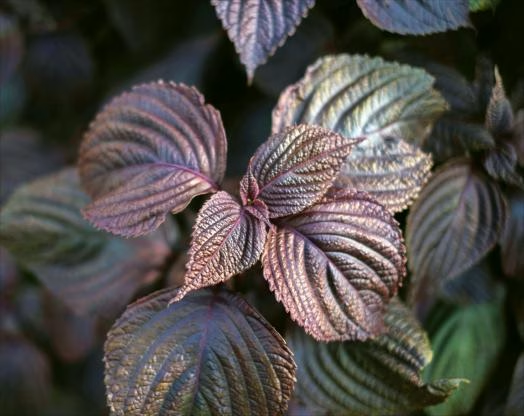Simply arrange perilla leaves around dishes. Serve with fish or pork dishes. The unique fragrance of perilla instantly dissolves the greasiness of the meat, leaving a refreshing and pleasant taste. The power of perilla is only felt when you take a bite.
Perilla leaves often quietly play a role as a spice. In fact, perilla can be used as both a medicine and a food, and almost the entire plant can be used. The leaves can be used in cooking, the purple-red juice can be used as a dye, and the seeds can be used to extract oil. How can perilla leaves be combined with other culinary ingredients? Let’s learn about the purple-red and green varieties of perilla:
Perilla can be used as both a medicine and a food, relieving greasiness and inhibiting bacteria.
Production Areas
Perilla is a spice plant with a distinctive, fragrant aroma. Its leaves are oval, pointed, and have serrated margins. It comes in purple-red and green varieties and is native to India, Southeast Asia, and China.
Benefits of Perilla Leaves: Medicinal and Edible
Perilla is both medicinal and edible. Dried perilla is used in Traditional Chinese Medicine for its benefits, including protecting the spleen and lungs, regulating the respiratory tract, regulating qi, and dissipating heat.
Perilla has a pungent and warming nature, and its aroma and flavor help regulate the spleen and stomach. Fresh perilla, when used in cooking, can stimulate the appetite and relieve greasiness.
An interesting legend claims that the renowned physician Hua Tuo discovered perilla leaves after seeing an otter become ill after eating fish. However, the symptoms resolved after eating perilla leaves, leading him to discover the magical properties of perilla. Components like perilla aldehyde in perilla have the potential to inhibit some bacteria, leading to the customary practice of adding a piece of perilla to Japanese sashimi. Besides relieving greasiness and adding flavor, it also seems to offer health benefits.
How should red and green perilla be eaten?
Perilla comes in two varieties, red and green, easily distinguishable by their color. The red variety has a vibrant purple-red hue, while the green variety is a bluish-green, with slightly different flavors.
Red-leaf perilla has a stronger flavor and a purple-red juice, making it ideal for pickling and sauces, such as perilla plums and perilla pickles, adding a touch of mystery to dishes. Green-leaf perilla, on the other hand, is lighter and is ideal as a vegetable accompaniment, whether in sashimi, meat rolls, grilled meats, or rice balls. It can be added to sashimi, minced, mixed, or brewed into tea for a refreshing palate-busting treat.
Perilla: Antioxidant and Eye Health Benefits You’ve Never Thought of
Perilla, with its distinctive flavor, contains a variety of volatile compounds, such as perillaldehyde and menthol, giving it a rich aroma.
Perilla’s nutritional value is not to be underestimated. It’s rich in vitamin A and carotene, which are beneficial for vision. It’s also rich in minerals like potassium and calcium, which support the development of nerve cells and bone. Its high vitamin C content makes it a superior antioxidant compared to many leafy vegetables and fruits.
Perilla leaf recipe
When cooking, use oil to help convert carotene into a more absorbable form. Avoid cooking for extended periods to maximize the benefits of perilla. Perilla can be eaten raw, so adding a leaf to meat dishes is ideal for a simple yet delicious addition. A moderate amount is recommended.
Pick the perilla leaves, rinse them, and dry them. Store in a cooler or freezer. Sun-dry the whole leaves, then finely chop them and store them in an airtight container for seasoning. Perilla leaves can be found in some markets and supermarkets, and are also suitable for gardening. Those who enjoy growing them can use them to create refreshing and unique dishes anytime.


Leave a Reply